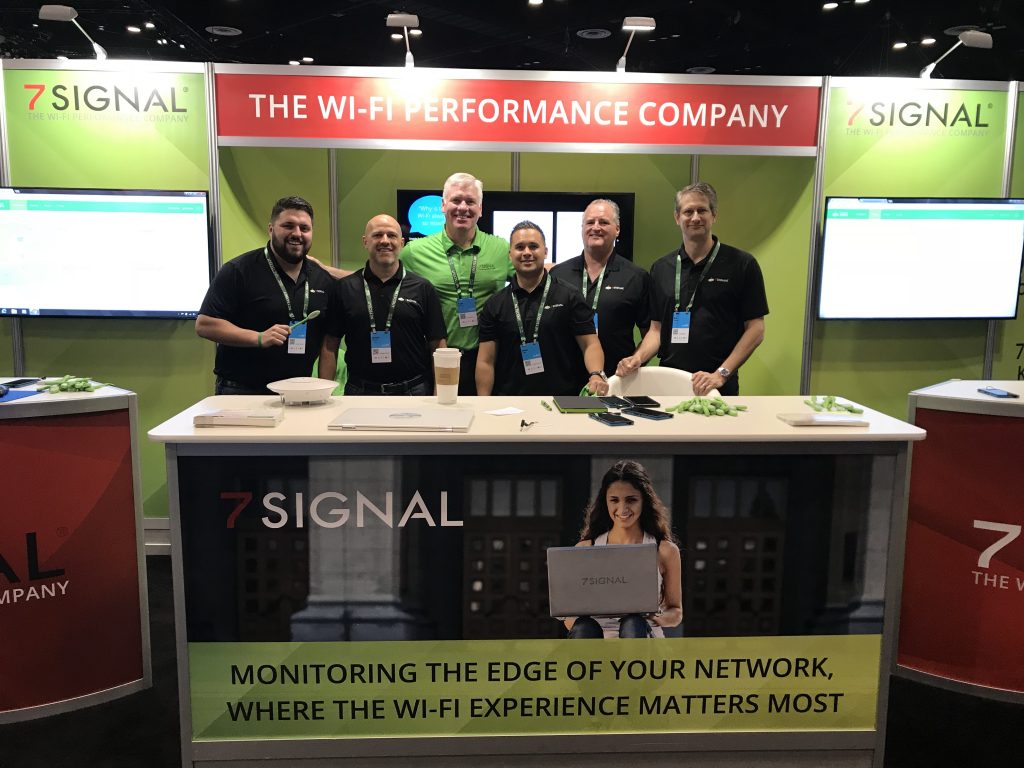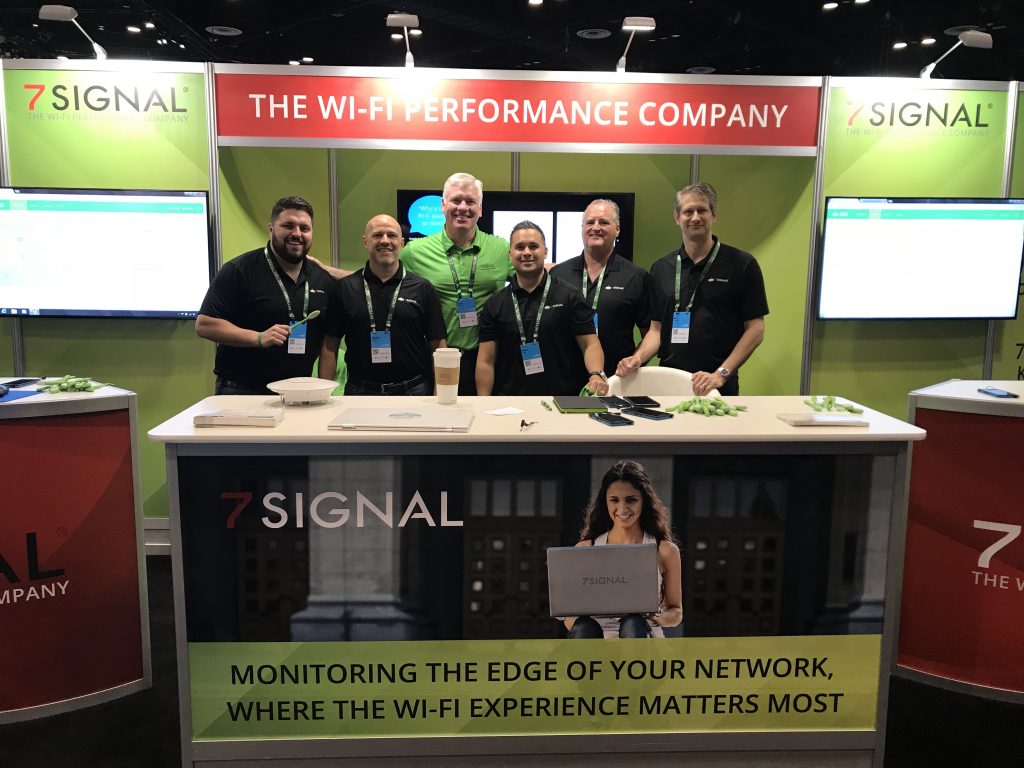
Blog
Mobile Eye Shows Off Unprecedented Visibility into Wi-Fi Experiences at Ciscolive 2018
Ciscolive 2018 is in the books and WOW what a great show! In addition to meeting up with a huge group of existing 7SIGNAL customers, we met hundreds of great people for the first time who were extremely interested in learning more about Wi-Fi performance management. This year our focus was on our Mobile Eye product for monitoring Wi-Fi experiences on laptops, scanners, pickers, tablets, workstations on wheels, and other devices. Our message of monitoring actual devices on the edge of the network resonated loudly and clearly with most IT professionals who were 'sick and tired' of getting blamed for poor Wi-Fi network performance when a majority of the issues trace back to client devices.

Think about it for a minute - the Wi-Fi network rarely changes. A good design should last 5 years. So where do many problems lie? It's the devices that change, update, and move around, which is why identifying and catching these issues is so elusive and difficult. The folks we met at Ciscolive were intelligent enough to understand this point quite clearly. After all, they don't like pointing fingers either. By the same token, they don't like be pointed at for things outside of their control. This is why they were so receptive to Mobile Eye's value proposition.
When demonstrating Mobile Eye at Ciscolive, booth visitors were most impressed by the 'Bottom 20 Adapters' report because they are all too aware of how adapters and drivers affect Wi-Fi performance. The report lists the adapter-driver combinations that perform worst on your network. There are potentially hundreds of combinations so a tidy report that sorts out what works well and what doesn't on the network was of huge interest. Additionally, the report shows you who owns the suspect devices so you take care of them proactively. We measure performance of the adapter-driver with the Throughput metric for speed, and the Sticky Factor for roaming. It's great when you have empirical, historical evidence of a device issue - and now we do.
Another Mobile Eye crowd-pleaser was demonstrating the ability to troubleshoot common Wi-Fi issues in less than 30 seconds. When you have historical and near-real-time visibility into the Wi-Fi client's experience, this is now possible. Often times, people in an organization complain about the Wi-Fi when in reality the network is performing just fine. For example, when a complaint about slow Wi-Fi is logged, an IT professional or helpdesk member can quickly and easily look up the person's device performance history with Mobile Eye to see if the device should have roamed but didn't. Remember - it's the device that controls the roam, not the network. To quickly identify these instances increases first call resolution and prevents escalations to scarce, highly specialized Wi-Fi engineers.
The Most Frequently Asked Questions
The most frequent question at Ciscolive was, "How are you different from Cisco DNA?" We knew it was coming and we were ready for it. The answer was simple, "Mobile Eye." Only 7SIGNAL's Mobile Eye is truly measuring from the client's point of view. We appreciate what Cisco is doing from a Wireless Assurance standpoint. Networks should indeed monitor themselves and provide self-healing if possible. But this is still from the infrastructure's point of view and it only gets you so far. By residing on the device, Mobile Eye tracks roaming history from network to network and from radio to radio, revealing the user experience detail required to identify root cause of the most common Wi-Fi issues and complaints.
The second most frequently asked question was, "What kind of impact does your agent have on the laptop?" There's no question that software agents have gotten a bad name because how they have a tendency to bog down a computer and negatively impact the user experience. Most agents are for security purposes and involve the periodic or real-time scanning and locking of files. But 7SIGNAL's Mobile Eye doesn't work that way. Mobile Eye's duty cycle consists of the following:
First, Mobile Eye collects and uploads scan data from the operating system, which consists of the SSID, BSSID, signal strength values, adapter, driver version, and a few other things. We're talking bytes here. Next, Mobile Eye pings a few servers and downloads a couple web pages to determine reachability. Again, bytes of data.
If there is any so-called heavy lifting then it's the Throughput test for measuring connection speed. But it's intelligent in that it does not 'flood the link' to determine max throughput. This is what you might get at speedtest.net by Ookla and is fine for taking the occasional test or two. But Mobile Eye isn't trying to achieve maximum throughput. It very realistically calculates an average throughput speed based on your network's use of dynamic bandwith allocation. The test runs for 5 seconds and is equivalent to uploading or downloading a file for the same amount of time. In our lab we saw an average increase in CPU utilization of 10% while the test was in process and negligible memory utilization.
To be blunt, the agent doesn't do terribly much and certainly is not a performance burden to the laptop in any way. The smarts of the entire 7SIGNAL system reside in the cloud where the reporting, charting, aggregating and analytics all take place. We call it EyeQ and in typical SaaS fashion, you login from anywhere to view device or access point performance from everywhere.
The third most asked question was indeed around our security. There's still a stigma attached to cloud based solutions, but 7SIGNAL has taken every measure to ensure security. After pushing out the application to your devices with SCCM, GPO or equivalent deployment software, the .msi or .pkg file self-installs. Your install script will include your unique Organization ID which represents your tenant in the cloud. There is one point-of-entry into the cloud and one point only, api.7signal.com which uses the Oauth 2.0 protocol for authentication with every device. This process takes place over https to insure secure and encrypted communications. In fact, all communications between device and cloud use https. When you login to EyeQ for reporting and management, you are accessing a Single Page Application (SPA) behind a global Content Delivery Network (CDN) to increase security and resiliency.
Unprecedented Visibility
This capability is a huge bonus for any IT team spinning it's cycles chasing down reported Wi-Fi issues reported from all over the world. Without proper device insight and visibility, the process of solving these issues is incredibly frustrating. But with Mobile Eye, common Wi-Fi issues can be identified and addressed in less than 30 seconds. We proved this to tons of folks at Ciscolive!